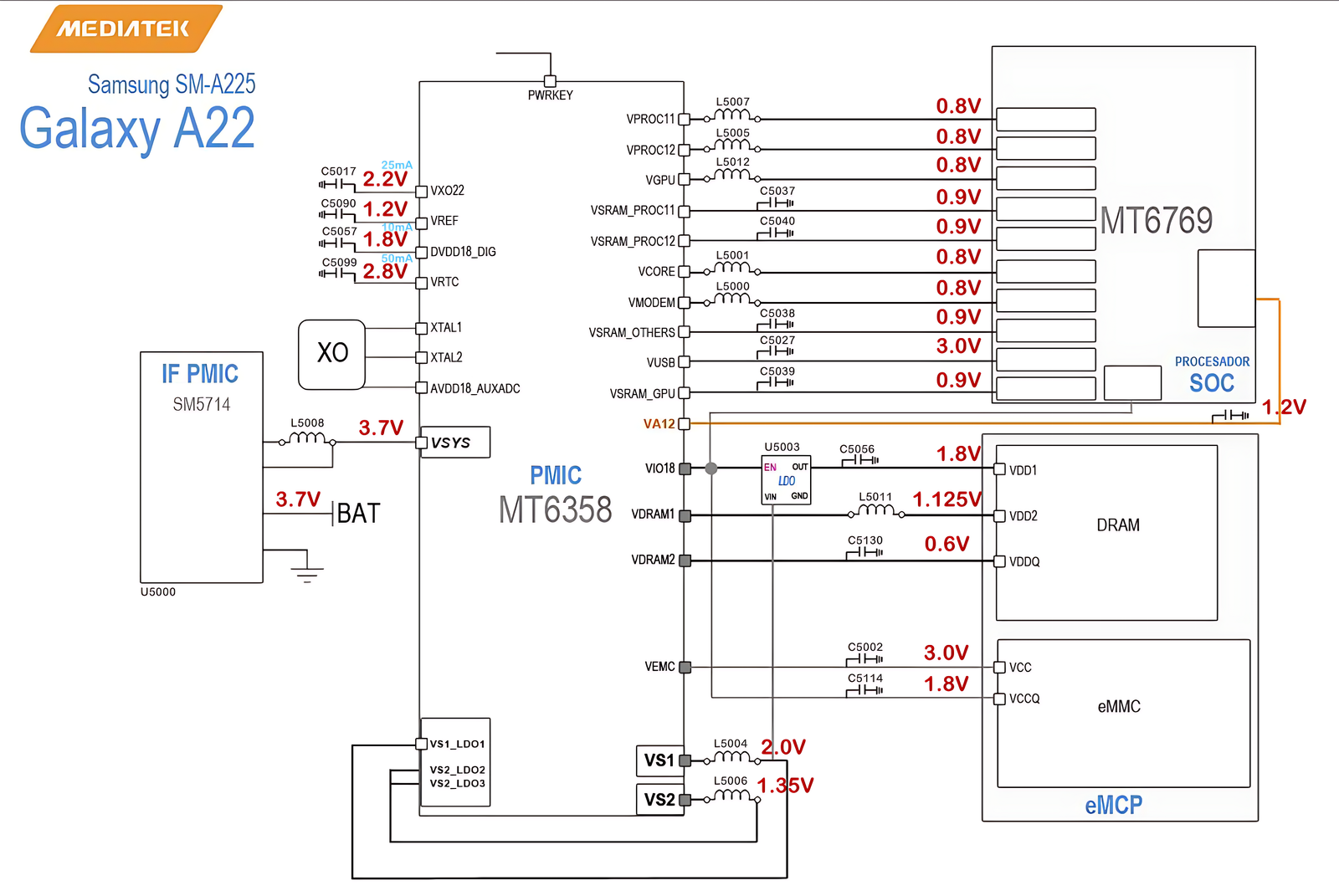Samsung Galaxy A32 (SM-A325) PMIC MT6358 Voltage Diagram
In the world of mobile electronics, power management is one of the most critical aspects of smartphone design. The Samsung Galaxy A32 (model SM-A325) powered by MediaTek’s MT6769 processor uses the MT6358 PMIC (Power Management Integrated Circuit) to ensure stable and efficient power distribution across its internal components. This article provides a comprehensive breakdown of the MT6358 PMIC, its voltage rails, and how it manages power delivery to the SoC, DRAM, eMMC, and other components in the device.

Understanding the Role of PMIC in Smartphones
A PMIC is essentially the heart of the power subsystem in modern smartphones. It converts the battery’s raw voltage (typically around 3.7V) into various regulated voltages that different parts of the system require. Without proper power regulation, components could overheat, malfunction, or get permanently damaged. The MT6358 used in the Galaxy A32 is a highly integrated power management solution tailored for MediaTek processors like the MT6769.
Battery Input and VSYS
The battery voltage (VBAT) is supplied at around 3.7V, which is typical for lithium-ion batteries. This voltage feeds into the MT6358 via the VSYS rail, which acts as the main input power rail for the PMIC. From here, the MT6358 generates various other voltage domains needed for different subsystems.
Voltage Rails and Their Functions
Let's break down the different voltage outputs visible in the diagram and what each one powers:
- VPROC11, VPROC12 (0.8V): These power rails are used to supply the main processor cores in the MT6769 SoC. Efficient low-voltage supply ensures lower power consumption and thermal output.
- VGPUB (0.8V): Supplies power to the GPU core for graphics processing tasks.
- VSRAM_PROC (0.9V): Powers the SRAM used by processor cores for fast data access.
- VCORE, VMODEM (0.8V): These are responsible for the core logic and modem operations respectively, critical for 4G LTE and data transmission.
- VSRAM_GPU (0.9V): Dedicated to the SRAM for the GPU.
- VUSB (3.0V): Powers USB interface circuits, allowing for data transfer and charging functionality.
- VX022, VREF, VRTC: These supply small but vital support circuits like oscillators and reference voltages.
DRAM and Memory Voltages
The DRAM subsystem in the Galaxy A32 requires three distinct voltages:
- VDD1 (1.8V): Main supply voltage for the DRAM chip.
- VDD2 (1.125V): Secondary voltage, typically used in LPDDR4/4X memory systems.
- VDDQ (0.6V): I/O voltage for data communication between the DRAM and SoC.
These voltages are precisely regulated to ensure high-speed data transfer with minimal noise and interference.
eMMC (Embedded MultiMediaCard) Power
The eMCP (Embedded Multi-Chip Package) shown in the diagram combines eMMC storage and DRAM. It requires:
- VCC (3.0V): For the main storage flash memory.
- VCCQ (1.8V): I/O voltage for communication with the controller.
Stable eMMC voltages are critical for consistent storage read/write operations and data integrity.
Low Drop-Out Regulators (LDO)
The LDO labeled U5003 is used to generate 1.8V from VA12 (an internal 1.2V rail). LDOs are often used when low noise is required, especially for analog or RF circuits. They are less efficient than switching regulators but more stable and clean in terms of output.
IF PMIC (S2MU106X01)
This chip is responsible for battery charging and protection. It delivers the 3.7V battery voltage to the MT6358 through the inductor L5008. This chip typically includes:
- Battery charging controller
- Over-voltage and thermal protection
- USB charging interface logic
The IF PMIC works in tandem with the main PMIC to ensure safe power flow from external power sources like USB to the internal battery and then to the rest of the system.
Clocking and Oscillators (XO, XTAL1, XTAL2)
The oscillator circuit (XO) and crystal pins (XTAL1 and XTAL2) ensure the timing and synchronization of the processor and peripheral functions. Power to these components is provided via VAUX18 (1.8V), ensuring a clean and stable clock signal.
Why Precise Voltage Control is Critical
Each component in a smartphone is designed to operate within a narrow voltage range. Any deviation can lead to:
- System instability
- Random reboots
- Overheating
- Permanent component damage
That’s why PMICs like MT6358 are so crucial — they don’t just supply power; they manage it with precision, efficiency, and safety mechanisms built in.
Conclusion
The Samsung Galaxy A32 SM-A325 leverages the power of the MT6358 PMIC to distribute clean, regulated voltages across the processor, memory, storage, and peripheral components. This intelligent power management ensures optimal performance, better battery life, and enhanced device longevity. By understanding the PMIC voltage map, technicians, engineers, and even advanced users can better diagnose issues, perform repairs, or optimize hardware designs for future upgrades.
Whether you’re a mobile repair engineer or an electronics enthusiast, a deep understanding of how the MT6358 powers the Galaxy A32 can give you valuable insights into the architecture of modern smartphones.
